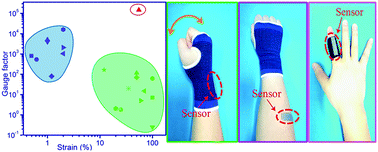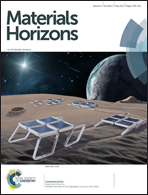Ultrasensitive and stretchable resistive strain sensors designed for wearable electronics†
Abstract
Advanced wearable sensors for human motion detection are receiving growing attention and have great potential for future electronics. Herein, we demonstrate microcrack-assisted strain sensors using silver nanowires@patterned polydimethylsiloxane. Through designed percolating network microstructures, the strain sensors have significant inherent advantages, including simple fabrication processes and ultrahigh sensitivity far surpassing other stretchable sensing devices. Noteworthily, the strain sensors possess a tremendous gauge factor (GF) of 150 000 within a large stretchability of 60% strain range. The sensing mechanism depends on the change in electrical resistance, which is dramatically affected by a percolating-microcrack surface microstructure in the case of strain concentration of mechanical deformation. The superior sensing performance in conjunction with an appealing stretchability, reversibility, low creep and ultrahigh stability enables the strain sensors to act as wearable monitors and electronic skins for diverse applications, including but not limited to full-range detection of human body motions, as well as visual control of a light-emitting diode indicator, etc.

- This article is part of the themed collection: Materials Horizons 10th anniversary regional spotlight collection: China


 Please wait while we load your content...
Please wait while we load your content...